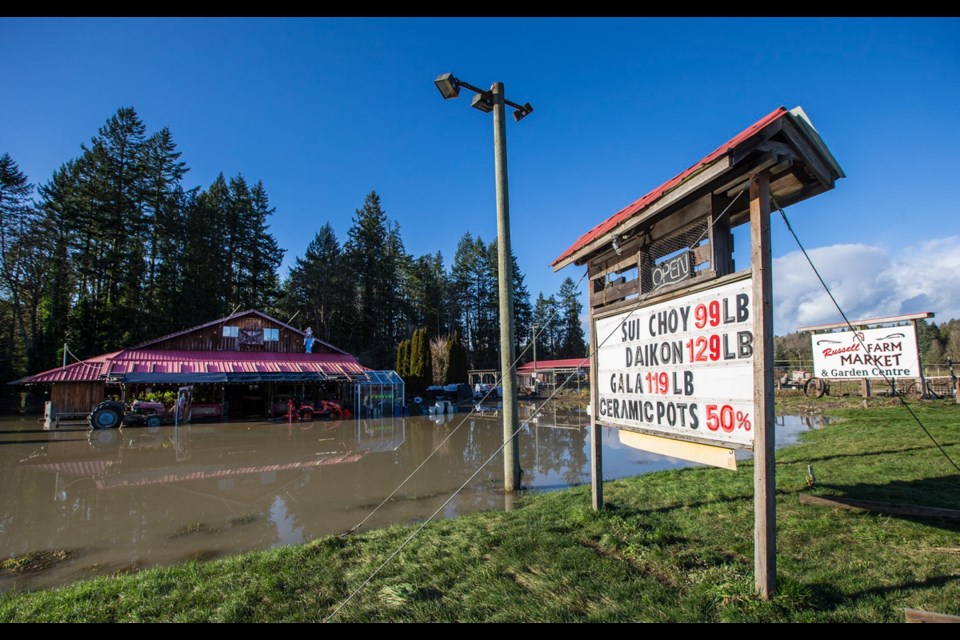Update:
The Cowichan Valley Regional District has rescinded the evacuation order for the Crofton/Westholme area of North Cowichan, but a state of local emergency remains in effect.
The evacuation order has been rescinded because the immediate threat has passed, and evacuated residents are now able to return to their homes. Residents returning to their flood-damaged homes should review the B.C. provincial Guide to Disaster Recovery prior to entering their home.
The CVRD will be opening a ‘resiliency centre’ at the Cowichan Community Centre to provide information and resources to those affected by flooding. This could include building assessment, counselling, information on cleanup, health support and answering potential questions around insurance.
The resiliency centre will be staffed by representatives from the CVRD Public Safety division, Red Cross and other partner agencies. The centre will be open:
• Monday, Feb. 3, from 12 p.m. to 8 p.m. in the Maple Room of the Cowichan Community Centre
• Tuesday, Feb. 4, from 12 p.m. to 8 p.m. in the Koksilah Room of the Cowichan Community Centre
The Emergency Operation Centre has been downgraded from a Level 2 to a Level 1, administered by CVRD Public Safety staff until such time as the state of local emergency is rescinded.
___________
Previous story:
Flooding on Vancouver Island Saturday displaced residents, closed roads and caused significant damage to buildings.
The Cowichan Valley Regional District declared a state of emergency early Saturday due to widespread flooding.
About 40 people in the Crofton area were moved to safety on Friday night due to flooding. Some were able to stay with family and friends, while others spent the night at the emergency reception centre at the Cowichan Community Centre.
There was no official evacuation order, but some residents requested emergency assistance after finding their homes filled with several feet of water, said Kris Schumacher, manager of communications for the regional district.
Schumacher called the situation “pretty serious.”
“People getting evacuated by boat from their houses. Cars flooded all the way above the windows.”
Clear, sunny skies came out on Saturday and water levels dropped significantly by the afternoon.
“Things are looking good. The levels and the flows of the rivers in the area have subsided substantially from last night’s levels,” Schumacher said.
The emergency reception centre shut down by about 2 p.m. Saturday but the state of emergency remained in effect.
At least one person sought medical attention due to the flooding.
Russell Farms Market and Garden Centre, a busy spot in Chemainus, suffered significant flooding.
“Most of the coolers and produce was all covered by water, because it was up to about five feet. So they’ve lost most of their goods,” said Alexis Puttick, a close friend of the owners, who lives just up the road from the market.
Puttick said it will likely be months before they can reopen.
The business was also damaged by a windstorm in late 2018 and in a fire last fall.
“They haven’t had it super easy,” said Puttick, who started a fundraising page for the owners to put towards an insurance deductible and any emergency costs.
The farm’s goats were rescued by the SPCA.
There were road closures across the Island, including the Trans-Canada Highway, which was closed in both directions just north of Duncan for several hours. The highway between Duncan and Chemainus reopened about 10:40 a.m.
Other roads were closed in the Halalt First Nation, Crofton and Port Renfrew. Bamfield Main was closed due to slides.
In Greater Victoria, there were lane closures on the Trans-Canada at McKenzie Avenue, where an interchange is being built and drainage systems haven’t been completed yet.
A mudslide caused intermittent closures of up to 15 minutes on Finlayson Arm Road in Goldstream Provincial Park.
The heavy rain caused overflows of combined stormwater and wastewater along shorelines in Greater Victoria overnight. The Capital Regional District advised residents to avoid entering the water in several areas of Esquimalt, Victoria, Oak Bay and Saanich, as the wastewater overflow is a potential health risk.
Environment Canada said on an atmospheric river of subtropical moisture from the Pacific, brought rainfall totals ranging from 60 to 120 millimetres for Vancouver Island, Metro Vancouver, the Fraser Valley and up the Howe Sound to Whistler.
The River Forecast Centre issued a flood warning for western and southern Vancouver Island, which means river levels have exceeded or will exceed river banks.
The public is asked to stay clear of fast-flowing rivers and potentially unstable riverbanks.



